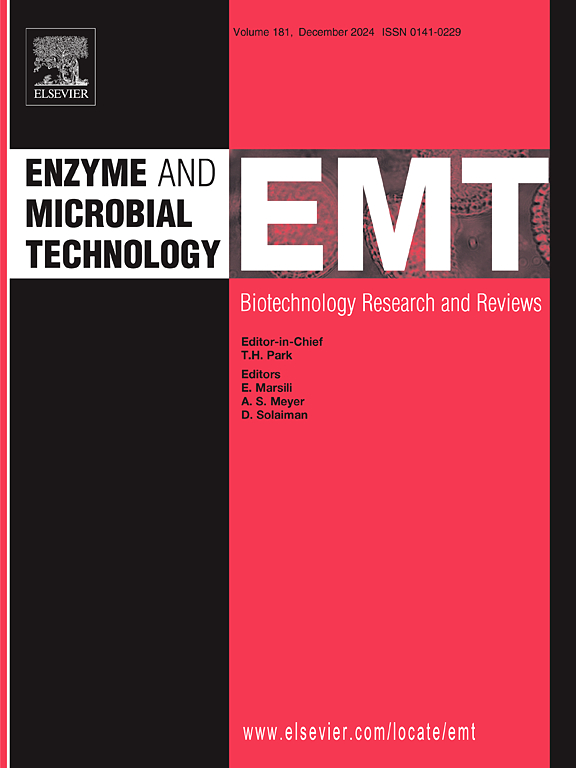Homologous expression and characterization of Coniochaeta ligniaria glycoside hydrolase family 115 α-glucuronidase
IF 3.7
3区 生物学
Q2 BIOTECHNOLOGY & APPLIED MICROBIOLOGY
引用次数: 0
Abstract
Generation of fermentable sugars from biomass is necessary for microbial production of bioproducts. Due to its inherent complexity, xylan hydrolysis to monosaccharides requires several different enzymatic activities. To completely depolymerize glucuronoarabinoxylan from biomass, α-glucuronidase activity is necessary. The ascomycete fungus Coniochaeta ligniaria has the ability to degrade xylan and is an unutilized source of biomass degrading enzymes. Therefore, a gene encoding a putative Coniochaeta ligniaria GH115 α-glucuronidase was cloned and expressed homologously in Coniochaeta ligniaria as a native secreted protein. Culture supernatants were concentrated and purified by a combination of ultrafiltration, anion-exchange, and size-exclusion chromatography. The purified protein behaved as dominantly dimeric complexes as determined by size-exclusion chromatography. The expressed protein liberated: 4-O-methyl glucuronic acid from beech xylan, birch xylan, and beech-derived glucuronoxylooligosaccharides as the sole product of hydrolysis; and 4-O-methyl glucuronic acid and glucuronic acid from oat spelt xylan. The expressed α-1,2-glucuronidase had greater activity on glucuronoxylooligosaccharides than on full length beech xylan. The expressed α-1,2-glucuronidase, herein designated ClAgu115, had Km values of: 1.3 mM; 1.2 mM; and 1.0 mM for beech xylan, GH10-hydrolyzed glucuronooligosaccharides, and GH11-hydrolyzed glucuronooligosaccharides, respectively. The measured kinetic constants show that the enzyme prefers an oligosaccharide substrate with the 4-O-methyl glucuronic acid on the non-reducing end. The enzyme had activity between pH 3.0–6.0 and temperatures 10°C-60°C, with optima at pH 4.3 and 40°C. The expression and characterization of ClAgu115 expands the repertoire of fungal GH115 enzymes for use in biomass conversion.
木质素螺毛菌糖苷水解酶家族115 α-葡萄糖醛酸酶的同源表达与鉴定
从生物质中产生可发酵糖是微生物生产生物产品所必需的。由于其固有的复杂性,木聚糖水解成单糖需要几种不同的酶活性。为了从生物质中完全解聚葡萄糖醛酸阿拉伯木聚糖,α-葡萄糖醛酸酶活性是必需的。子囊菌木质素Coniochaeta ligniaria具有降解木聚糖的能力,是未利用的生物质降解酶的来源。因此,我们克隆了一个推测为木质素毛刀菌GH115 α-葡糖醛酸酶的基因,并将其作为天然分泌蛋白在木质素毛刀菌中同源表达。培养上清通过超滤、阴离子交换和尺寸排除层析的组合进行浓缩和纯化。纯化后的蛋白主要表现为二聚体复合物,通过尺寸排除层析确定。所表达的蛋白作为水解的唯一产物,从山毛榉木聚糖、桦木聚糖和山毛榉衍生的低聚葡萄糖醛酸中释放出4- o -甲基葡萄糖醛酸;4- o -甲基葡萄糖醛酸和4- o -甲基葡萄糖醛酸来自燕麦斯佩尔木聚糖。α-1,2-葡萄糖醛酸酶对低聚葡萄糖醛酸的活性高于对全长山毛榉木聚糖的活性。表达的α-1,2-葡糖醛酸酶,本文命名为ClAgu115,其Km值为:1.3 mM; 1.2毫米;山毛榉木聚糖、gh10水解的低聚葡萄糖醛酸糖和gh11水解的低聚葡萄糖醛酸糖分别为1.0 mM。测定的动力学常数表明,酶倾向于低聚糖底物,在非还原端有4- o -甲基葡萄糖醛酸。该酶在pH 3.0 ~ 6.0、温度10℃~ 60℃范围内具有活性,pH 4.3和温度40℃时活性最高。ClAgu115的表达和鉴定扩大了真菌GH115酶用于生物质转化的范围。
本文章由计算机程序翻译,如有差异,请以英文原文为准。
求助全文
约1分钟内获得全文
求助全文
来源期刊

Enzyme and Microbial Technology
生物-生物工程与应用微生物
CiteScore
7.60
自引率
5.90%
发文量
142
审稿时长
38 days
期刊介绍:
Enzyme and Microbial Technology is an international, peer-reviewed journal publishing original research and reviews, of biotechnological significance and novelty, on basic and applied aspects of the science and technology of processes involving the use of enzymes, micro-organisms, animal cells and plant cells.
We especially encourage submissions on:
Biocatalysis and the use of Directed Evolution in Synthetic Biology and Biotechnology
Biotechnological Production of New Bioactive Molecules, Biomaterials, Biopharmaceuticals, and Biofuels
New Imaging Techniques and Biosensors, especially as applicable to Healthcare and Systems Biology
New Biotechnological Approaches in Genomics, Proteomics and Metabolomics
Metabolic Engineering, Biomolecular Engineering and Nanobiotechnology
Manuscripts which report isolation, purification, immobilization or utilization of organisms or enzymes which are already well-described in the literature are not suitable for publication in EMT, unless their primary purpose is to report significant new findings or approaches which are of broad biotechnological importance. Similarly, manuscripts which report optimization studies on well-established processes are inappropriate. EMT does not accept papers dealing with mathematical modeling unless they report significant, new experimental data.
 求助内容:
求助内容: 应助结果提醒方式:
应助结果提醒方式:


